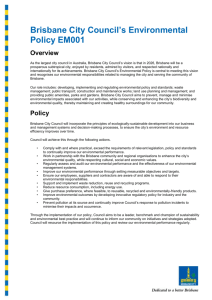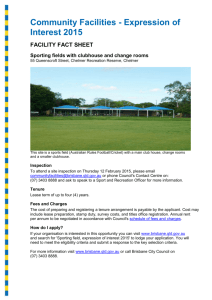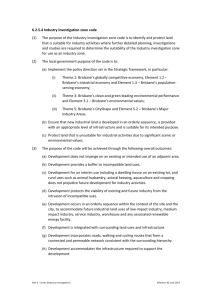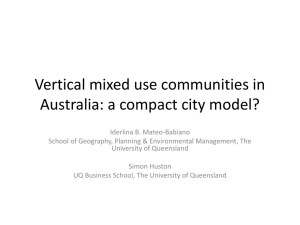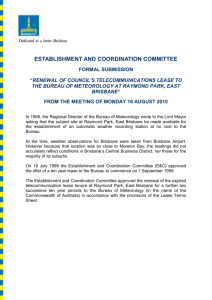Accessible Word Template
advertisement
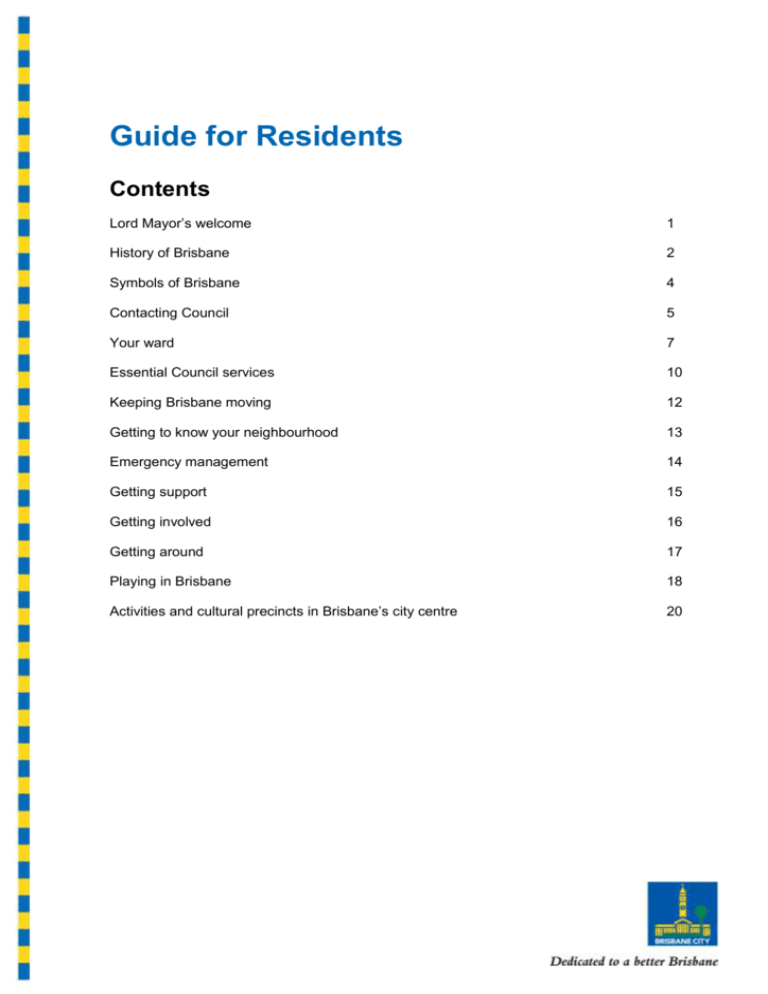
Guide for Residents Contents Lord Mayor’s welcome 1 History of Brisbane 2 Symbols of Brisbane 4 Contacting Council 5 Your ward 7 Essential Council services 10 Keeping Brisbane moving 12 Getting to know your neighbourhood 13 Emergency management 14 Getting support 15 Getting involved 16 Getting around 17 Playing in Brisbane 18 Activities and cultural precincts in Brisbane’s city centre 20 Lord Mayor’s welcome Welcome to Brisbane! With our leafy streets and parks, exciting cultural events, beautiful sub-tropical climate and strong sense of community - we are truly a great city to live in. Over the past decade, Brisbane has undergone a significant period of growth to become a dynamic and vibrant new world city. As Lord Mayor, I’m committed to delivering for the residents of Brisbane and growing our city to its full potential. This involves delivering vital infrastructure, planning for the future, maintaining a clean and green city and strengthening Brisbane’s economy. This guide has been designed to give you a brief introduction to Brisbane and to the many services and facilities Brisbane City Council provides to residents. If you’re new to the city, this guide will help you to settle in and get around. I hope you will enjoy living here and I look forward to working with you to make Brisbane an even better place to live. Graham Quirk Lord Mayor 1 History of Brisbane More than 7000 years ago – Indigenous clans successfully adapt their lifestyle to post Ice Age changes in the area we now call Moreton Bay 1770 – Captain James Cook sails up the Queensland coast with botanist Joseph Banks and names Cape Moreton, Point Lookout and Glass House Mountains 1823 – Surveyor-General John Oxley arrives at Bribie Island to evaluate Moreton Bay as a site for penal settlement 1839 – Moreton Bay is closed as a penal settlement 1859 – Brisbane declared a municipality; John Petrie elected as first Mayor 1885 – Horse drawn tram system commences operation 1890 – Brisbane River floods 1893 – Brisbane River floods 1897 – Electric trams introduced 1901 – Fire alarms and pillar hydrants introduced to Brisbane’s city streets 1925 – Amalgamation of 25 local government areas to form the City of Brisbane 1925 – Brisbane City Council assumes control of the tram system 1930 – Brisbane City Hall opened 1940 – Story Bridge completed 1964 – Adoption of first Brisbane Town Plan 1974 – Brisbane River floods 1982 – Commonwealth Games held 1986 – Gateway Bridge completed 1988 – Expo 88 held at reclaimed industrial land at South Brisbane 2001 – Brisbane hosts the Goodwill Games 2006 – Our Shared Vision, Living in Brisbane 2026 (currently known as Brisbane Vision 2031) released after extensive community consultation 2007 – Tunnelling begins on the CLEM7 tunnel project 2009 – Brisbane celebrates its 150th anniversary as a municipality 2010 – CLEM7 tunnel and Go Between Bridge completed. City Hall closed to undergo restorations 2011 – Brisbane River floods 2 2012 – Tunnelling commences on Legacy Way tunnel project 2013 – City Hall reopens after a three-year restoration Visit the Museum of Brisbane, or Brisbane’s Living Heritage Network for more information about Brisbane and its historical buildings and places. 3 Symbols of Brisbane Brisbane’s City Hall is the basis of the official corporate logo of Brisbane City Council. For many Brisbane people, City Hall is the community and cultural centre of Brisbane – a place of stability, which has weathered the years of development around it. Brisbane’s official coat of arms features two gryphons, chosen for their spirited and animated nature, which support the city shield. The shield’s design pays tribute to Sir Thomas Brisbane, a prominent astronomer after whom the city is named. The shield’s symbols represent commercial activity a peace, while the motto Meliora Sequimur means ‘We aim for the best’. The colours of the city, blue and gold, are reflected in the wreath at the top. Brisbane’s official flag is based on the coat of arms and is flown daily in King George Square outside City Hall. It features gold caducei (winged staffs entwined and serpents), gold gryphons, gold Stafford knots, white stars, and white and navy lines on a blue background. When greater Brisbane became an entity on 1 October 1925, the red poinsettia was chosen by the people as the floral emblem. Although indigenous to Mexico, the poinsettia grows perfectly in Brisbane, bringing a glorious splash of colour to winter gardens. In 1996, the graceful tree frog became the city’s faunal emblem. It is noted throughout the region for its beautiful colours and distinctive ‘rain song’, which can be heard from thick vegetation, billabongs, creeks, wetlands, or Brisbane backyards, especially during the spring and summer rains. 4 Contacting Council When you contact Council you can expect to be treated with honesty, fairness, sensitivity and dignity. This commitment to service is outlined in Brisbane’s Customer Charter. For a copy of this charter, visit www.brisbane.qld.gov.au or ask for one to be mailed to you when you call us. There are a number of ways you can get in touch with Council. Phoning Council The Contact Centre operates 24 hours a day, seven days a week and can be contacted on (07) 3403 8888. For business-related enquiries, contact Council’s dedicated 24/7 business hotline on 133 BNE (133 263) or email 133BNE@brisbane.qld.gov.au Council also offers many contact options for deaf and visually and speech impaired customers: • The National Relay Service is available 24 hours a day, seven days a week through their website at www.relayservice.com.au • The Internet Relay Service is also available by connecting to the National Relay Service website • The Video Relay Service can also be utilised by calling Skype name: ace.vrs and asking the video interpreter to phone (07) 3403 8888. • If you have a hearing impairment you can contact Council by phoning the TTY (teletypewriter) service on 13 36 77 • If you have a speech impairment, you can contact Council by phoning the Speak and Listen service on 1300 555 727 Council also provides Auslan interpretation support to deaf residents who want to participate in a Council event or who need to meet with a Council officer to discuss a matter that cannot be easily resolved over the telephone or by correspondence. Translating and interpreting service The Australian Government’s Translating and Interpreting Service National can assist culturally and linguistically diverse audiences to access Council’s information. To use this service, call 131 450 and ask to speak to Brisbane City Council on (07) 3403 8888. Council online An easy way to find out information about Council is by going online to www.brisbane.qld.gov.au. The website contains a wealth of up-to-date information about Council’s vision for Brisbane, current projects, services and facilities. It also gives you the convenience of doing business with Council online where you can: • pay your rates and other Council accounts • lodge and view development applications • change your address details • renew your animal registration or search for a lost pet. 5 Regional Business Centres At Regional Business Centres, staff can help you with regulatory information and professional advice on things like local laws, permits and applications. Regional Business Centres operate from 8.30am to 4.45pm Monday to Friday. For your nearest Regional Business Centre, please visit our website or call our Contact Centre. Council’s Business Lounge is located in the Library and Customer Centre at Brisbane Square, 266 George Street in the city. It provides the same services as Regional Business Centres, as well as specialised development and regulatory services and assistance. The Business Lounge is open from 9am to 5pm, Monday to Friday. Writing to Council You can also write to Council at: Brisbane City Council GPO Box 1434 Brisbane QLD 4001. Reporting maintenance problems If you identify something that needs fixing in your street, local park or neighbourhood, you can let Council know by: calling the Contact Centre on (07) 3403 8888 completing a Fix-O-Gram form online at www.brisbane.qld.gov.au taking a photo using your mobile phone and sending it to 0429 2 FIX IT (0429 234 948) with the address and issue details. Online mapping Get all the information you need about Council services in your area from Council’s online mapping tool. Available free from Council’s website, it provides detailed map information and search functionality to help you find local services like libraries, parks and pools, events in your suburb, bus, CityFerry and CityCat stops, bin collection services, waste transfer stations, immunisation services and car parking facilities. 6 Your ward Brisbane City Council has 26 wards, each represented by a councillor who is elected by ward residents to represent their community’s needs. Brisbane City residents elect the Lord Mayor. Visit the Electoral Commission of Queensland website at www.ecq.qld.gov.au to find out what ward you live in and to confirm if you are on the electoral roll. Brisbane City Council elections are held every four years. Voting is compulsory for all residents who are Australian citizens over 18 years of age. Contacting your Council ward Lord Mayor Phone (07) 3403 4400 Email lord.mayor@brisbane.qld.gov.au Bracken Ridge Phone (07) 3667 6000 Email brackenridge.ward@ecn.net.au Central Phone (07) 3403 0254 Email central.ward@ecn.net.au Chandler Phone (07) 3407 1400 Email chandler.ward@ecn.net.au Deagon Phone (07) 3667 6011 Email deagon.ward@ecn.net.au Doboy Phone (07) 3407 8800 Email doboy.ward@ecn.net.au Enoggera Phone (07) 3407 2510 Email enoggera.ward@ecn.net.au Hamilton Phone (07) 3403 1095 Email hamilton.ward@ecn.net.au Holland Park Phone (07) 3403 2101 Email hollandpark.ward@ecn.net.au Jamboree Phone (07) 3407 7000 Email jamboree.ward@ecn.net.au Karawatha Phone (07) 3407 0566 Email karawatha.ward@ecn.net.au 7 MacGregor Phone (07) 3407 8500 Email macgregor.ward@ecn.net.au Marchant Phone (07) 3407 0707 Email marchant.ward@ecn.net.au McDowall Phone (07) 3403 7690 Email mcdowall.ward@ecn.net.au Moorooka Phone (07) 3403 1730 Email moorooka.ward@ecn.net.au Morningside Phone (07) 3407 8200 Email morningside.ward@ecn.net.au Northgate Phone (07) 3403 2210 Email northgate.ward@ecn.net.au Parkinson Phone (07) 3131 7022 Email parkinson.ward@ecn.net.au Pullenvale Phone (07) 3407 0220 Email pullenvale.ward@ecn.net.au Richlands Phone (07) 3407 1211 Email richlands.ward@ecn.net.au Tennyson Phone (07) 3403 8605 Email tennyson.ward@ecn.net.au The Gabba Phone (07) 3403 2165 Email thegabba.ward@ecn.net.au The Gap Phone (07) 3407 1900 Email thegap.ward@ecn.net.au Toowong Phone (07) 3403 2520 Email toowong.ward@ecn.net.au Walter Taylor Phone (07) 3407 0005 Email waltertaylor.ward@ecn.net.au 8 Wishart Phone (07) 3403 7791 Email wishart.ward@ecn.net.au Wynnum Manly Phone (07) 3403 2180 Email wynnummanly.ward@ecn.net.au 9 Essential Council services Waste and recycling Council is committed to managing Brisbane’s waste by increasing recycling, resource recovery and reducing waste to landfill. Council provides residents with a three bin waste collection service that includes a recycling bin (yellow lid, either 240 or 340 litre) for all your household recyclable items, a general waste bin (red lid) for non-recyclable items, and the option of a green waste recycling bin (bright green lid) for all your lawn clippings, pruning and leaves. General waste bins are provided for waste that is non-recyclable and are collected weekly, including public holidays. Red lids are gradually being introduced to replace the existing dark green lids on the general waste bins. As a new resident you can help us by recycling all your paper, cardboard, glass, metals and plastics in your yellow-lidded recycling bin and recycling your garden waste by either using it on your own garden as compost or mulch, taking it to your local transfer station or putting it into your green-lidded recycling bin. Council makes recycling easy with fortnightly kerbside collection from your home of your household recycling bin and green waste recycling bin (alternate week to your yellow-lidded bin). Once household recyclables are collected they are taken to a recycling facility where they are sorted and processed, ready to move to the next stage of the recycling process. Green waste is processed ready for reuse. In addition to the regular collection of household recycling and waste, Council also provides: • transfer station facilities at Nudgee, Willawong, Chandler and Ferny Grove for the recovery of electronic waste, household hazardous waste, oil, cardboard and metal, green waste, white goods and unwanted household items that can be donated to Council’s Tip Shops • annual large items collection by suburb, for the collection of unwanted household items that are too big for household wheelie bins like fridges, lino or carpet, wood products and furniture • four free household hazardous waste collection events at Council transfer stations for the safe recovery and disposal of swimming pool chemicals, engine oil, batteries, insecticides, gas bottles, paint and solvents • Tip Shop facilities at 27A Prosperity Place, Geebung and 46 Colebard Street West, Acacia Ridge. Items are collected from the four Council transfer stations and prepared for sale to the public by the Endeavour Foundation. The Tip Shops are open Saturday and Sunday 8am to 4pm. By rethinking your rubbish you can help make Brisbane a more sustainable, green and clean city. For more information about waste and recycling in Brisbane visit www.brisbane.qld.gov.au or call Council on (07) 3403 8888. Immunisation Brisbane City Council is one of the few local authorities in Australia to provide a free child immunisation program to protect against a range of diseases. Clinics are held regularly throughout Brisbane. Flu vaccinations are provided for seniors at select locations during the flu season. 10 Buying property in Brisbane Council’s Planning and Development Online service gives you direct access to property, planning and development information specific to Brisbane. You can also lodge searches online and order building plans for certain properties. For more information, visit pdonline.brisbane.qld.gov.au 11 Keeping Brisbane moving Council is delivering on a range of strategies to make getting around in Brisbane faster, easier and safer. Improving local roads Council is committed to improving local roads, investing several billion dollars in an effort to reduce traffic bottlenecks, notorious black spots and congestion on suburban roads. This investment will make our local network more free-flowing, less congested, and safe. Additionally, Council’s TransApex ring-road solution is a long-term plan to improve cross-city travel in Brisbane. It will provide new river crossings and connect existing motorways and major arterial roads to reduce congestion and deliver significant time savings. One such project, Legacy Way, is estimated to deliver travel time savings of up to 66% by 2026. Active Transport To reduce carbon emissions and take advantage of Brisbane’s perfect climate, Council has invested more than $100 million in bikeways and walkways. For location information and maps of the walkways and bikeways around Brisbane, please visit Council online at www.brisbane.qld.gov.au CityCycle bike hire CityCycle is an active and sustainable Council initiative aimed at reducing traffic congestion and parking pressure in Brisbane’s inner city. Bike hire stations are located at key destinations linking to bus, train and ferry connections. Public transport Buses, CityCats, CityHoppers and CityFerries operate seven days a week, and are a convenient and environmentally friendly way to travel. For those areas where public transport is limited, Council provides Personalised Public Transport. Eight fixed route services are provided throughout Brisbane with the service available to residents and visitors alike. Council also offers a shared taxi service called Council Cabs. This service is available for residents in certain suburbs who find it difficult to get to their local shops. For further information about other public transport options in Brisbane, and South East Queensland, visit www.translink.com.au or call TransLink on 13 12 30. 12 Getting to know your Neighbourhood Keeping pets You may need to have a permit to keep certain types of animals in Brisbane. All Brisbane pet owners need to follow pet ownership laws to ensure pets and animals don’t become a nuisance to the community or our native wildlife. Building and development If you’re planning to add a pool or deck, subdivide a property or undertake any other building or renovation project in Brisbane, you’ll need to get the appropriate development approvals from Council. Council can also help you with various searches, plumbing and drainage applications, and fencing information. 13 Emergency management Fire management Prescribed or controlled burning on Council land is used to maintain the health of forest ecosystems and to lessen the impact of bushfires. Prescribed burning reduces the build-up of fire fuels, such as sticks and leaves, which make bushfires hard to control. Storms and flooding Certain areas in Brisbane can be prone to flooding at different times of the year. Council plays an important role in water cycle management. Some flooding, however, cannot be prevented, so you should find out the flood risk where you live. Brisbane City Council is the first council in Australia to launch a free online flood report for Brisbane properties to help home owners and tenants understand their flood risk. Council also provides helpful information about what precautions to take in the event of a flood and what to do and who to call in a flood event. Visit www.brisbane.qld.gov.au/beprepared for more information. Free Early Warning Alert Service The Brisbane Early Warning Alert Service is free and allows residents in the Brisbane City Council Local Government Area to register for severe and urgent weather alerts via email, SMS and/or home phone. Alerts are location-based with warnings to be sent if your residence may be impacted. For more information about this service please visit Council’s website at www.brisbane.qld.gov.au/beprepared. 14 Getting Support Specialty services Brisbane City Council provides a range of facilities and services that make it easier for everyone to access the city’s services. Council libraries include materials in alternate formats suitable for people with sensory disabilities for borrowing. Council has community halls available for public hire that are accessible to people with mobility impairments, and many buses, trains, ferries and special taxi services are designed for easy access. In addition, eligible residents can apply to the Queensland Department of Transport and Main Roads for disability parking permits. Council’s Good Neighbour Clean-Up Scheme assists residents who are either aged, frail or have a disability, by taking unwanted items to Council transfer stations. There is no cost for this service as dedicated volunteers are provided with vouchers to use at the transfer stations. For more information, contact Council on (07) 3403 8888. Local laws Under the Local Government Act, Brisbane City Council has the authority to make and enforce local laws. Council is also responsible for enforcing some Queensland Government legislated laws. Council’s Compliance and Regulatory Services team is responsible for enforcing these laws relating to: • natural assets • parking regulations • animal management • abandoned vehicles • neighbourhood nuisances. A full list of Council’s local laws is available from our website. You can also get copies from your local Regional Business Centre. For your nearest centre, please visit our website or contact us by phone. 15 Getting involved You can contribute to the lifeblood of your community and to the future of Brisbane. Your City Your Say The Your City Your Say survey gives you the opportunity to learn about and have input into the issues affecting Brisbane. You can become a member by registering online. Neighbourhood Planning Neighbourhood Planning is all about Council and the community working together to decide what Brisbane will be like in 20 years. If you live, work or own property or a business in Brisbane you can get involved when Council undertakes a Neighbourhood Plan in your area. Visit our website to read Council’s current Neighbourhood Plans, join in a discussion forum, or make a submission. Visit Council’s website to find out more about Neighbourhood Plans that Council and the community have adopted and plans being drafted. You can join in a discussion forum or find out how to make a submission. Protecting the environment Another way you can make a difference to your local environment is by getting involved with volunteer conservation agencies. Help your community restore natural habitats in parks, bushland, wetlands and waterways through the Habitat Brisbane program. You can also join your local creek and catchment community group and help take care of some of the13,500 square kilometres of land bounded by natural features such as hills, from which all runoff flows to a common low point such as a creek, lake, river or bay. Homeless Connect Homeless Connect brings together Brisbane City Council, Queensland Government, businesses and community groups to provide free services to homeless people. For more information on these programs and initiatives please visit Council’s website at www.brisbane.qld.gov.au. 16 Getting around Bikeways The city’s cycling network consists of more than 1100km of on and off-road bikeways and separated pedestrian and bicycle paths. It is legal under Queensland law to cycle on footpaths unless signed otherwise, but cyclists must give way to pedestrians. Visit www.brisbane.qld.gov.au for more information about cycling in Brisbane. You’ll find handy maps, safety tips and information about parking. Council’s King George Square Cycle Centre provides a range of services including secure bike storage, lockers, showers and laundry facilities. Traffic management For the latest updates on Brisbane’s traffic, you can call the Traffic Report Line on 13 19 40 or check online at www.131940.qld.gov.au prior to your journey. Parking in Brisbane Brisbane City Council regulates parking in Brisbane. There are a number of general parking rules and regulations you should be aware of to avoid being fined, or having your car towed. Traffic and parking control areas are regulated and defined by boundary signs in both residential and business areas. To find out if your street is in a parking control area, please visit our website or phone Council on (07) 3403 8888. Pay attention to any road markings or signs that may indicate specific parking conditions that apply, such as special parking zones and limits in traffic and parking control areas. Council also operates parking meters in Brisbane, as well as parking stations at King George Square and Wickham Terrace in the city. Tips for bus travel • Arrive at your stop five minutes before the departure time. • Have your go card or the correct fare ready. • If you have a concession card, have it ready to show the driver. • Raise your hand to hail the bus to stop. • To get off the bus, ring the bell as the bus approaches your stop. • When you get off, wait for the bus to leave before crossing the road. How to buy a go card The Queensland Government has introduced the go card – TransLink’s travel card which stores up to $250 so you can travel seamlessly on TransLink bus, ferry and train services. You can buy online, at go card retailers, or over the phone by calling TransLink on 13 12 30. Visit www.translink.com.au to find out more about buying and topping up a go card. 17 Playing in Brisbane Brisbane is a vibrant entertainment, cultural and sporting centre with a lively retail and sumptuous dining scene. It also has some incredible parks and green spaces to pursue outdoor activities. What’s on There’s always plenty to see and do in and around Brisbane. Find out about the wide range of free Council events and activities, including sports and outdoor activities, tutorials, exhibitions, entertainment, and school holiday programs, from our What’s On page at www.brisbane.qld.gov.au. Visit the site for news and reviews on Brisbane’s popular dining precincts, our great pubs and clubs, local markets and a range of other activities happening throughout the city, from TV and movie guides, to festivals, markets and sporting events. Subscribe free to Council’s enewsletters for regular updates on different things you can see and do all year round. Council manages and maintains a range of recreational facilities including parks and gardens, community halls, and sporting facilities such as: • golf courses • boat ramps • pools • tennis courts • skate parks. Access to free Wi-Fi is available in 22 Council parks. For more information, visit www.brisbane.qld.gov.au. Recreation programs Good health is the cornerstone to enjoying life in Brisbane. Council supports a range of recreation programs that help residents lead healthy and active lifestyles. Bookings for these programs can be made by calling Council on (07) 3403 8888. Below are just some of the programs Council has on offer. GOLD (Growing Older and Living Dangerously) – provides free or low-cost activities for people aged 50 years and over. Chill Out – offers exciting activities for young people between the ages of 10 and 17 years. The programs are held around Brisbane most school holidays and offer a range of sporting, cultural and art activities. Visible Ink – this program encourages young people to take part in their city, and have a say in Council’s activities, programs and policies. Black Diamonds – is a program of community activities, programs and events for young Indigenous people (7-25 years) such as hip hop and R&B workshops, leadership and survival camps and development workshops. Council libraries Brisbane City Council's libraries are vibrant, busy places that help thousands of people find all sorts of information. There are 33 libraries located across the city, and a mobile library that visits some of the outer suburbs. Council’s libraries offer a broad range of fiction and non-fiction books, 18 newspapers, magazines, CDs, DVDs, eBooks, AudioBooks and access to free Wi-Fi. Several libraries also hold collections in languages other than English. Council libraries provide free activities for everyone, including informative seminars, workshops, author talks, computer classes, storytime sessions, homework help and book club meetings. Visit Council’s website or contact us by phone to find out about library opening hours and locations, facilities, membership, events and much more. 19 Activities and cultural precincts in Brisbane’s city centre Brisbane is a vibrant arts metropolis boasting a range of arts and cultural venues and activities. City Hall Built between 1920 and 1930, the heritage-listed City Hall is seen as the heart of Brisbane and is the backdrop to many cultural, social and civic events across the year. Having undergone a $215 million restoration, City Hall is the perfect place to explore Brisbane’s history with daily guided tours showcasing the Main Auditorium, Father Henry Willis Organ and the iconic clock tower. The Museum of Brisbane, another feature of City Hall, showcases artworks from the City of Brisbane collection as well as contemporary exhibitions by some of the city’s leading artists. Brisbane Greeters tour Brisbane Greeters are passionate local guides who offer free walking tours of Brisbane across four categories: Arts and Culture, History and Heritage, Family Fun and Architecture. For more information visit www.brisbanegreeters.com.au. Vibrant laneways Council is committed to the vibrant laneways and small spaces program, which identifies and rejuvenates these forgotten spaces reintroducing them to our community in a way that is imaginative, fun and engaging. Completed transformations include Burnett Lane, Winn Lane, Jacob’s Ladder, Market Street and Little Roma Street. South Bank South Bank has a reputation for securing large-scale musicals and international art exhibitions, while having a more playful side as a popular destination for locals and tourists to bask in the sunshine, swim in the man-made beach, or relax at the cafés, parks and boardwalks. Brisbane’s premier performance venue, the Queensland Performing Arts Centre (QPAC), gives Brisbane a platform to host a world class program of events all year, including ballet, opera and musicals. QAGOMA Queensland's premier visual arts institution, the Queensland Art Gallery | Gallery of Modern Art (QAGOMA), connects people and art through a dynamic program of Australian and international exhibitions that showcase works from a diverse range of historical and contemporary artists. New Farm’s Brisbane Powerhouse is another creative hub that presents outstanding local, national and international drama, music, cabaret, visual arts, film festivals and comedy. The Judith Wright Centre of Contemporary Arts in Fortitude Valley shows work by independent Brisbane artists and local and international musicians as well as edgy performances featuring electronic and world music, performance art and cabaret. 20 Indigenous culture Brisbane has a strong and proud Aboriginal and Torres Strait Islander heritage. Council works with local Indigenous people to preserve and celebrate their unique culture through arts, sporting and cultural activities. Aboriginal Cultural Trails There are three bushland culture trails in Brisbane that celebrate and preserve local Aboriginal Cultural heritage. Boondall Wetlands – this trail consists of 18 aluminum sculptures which reveal how Aboriginal clans used the land, flora and fauna of the wetlands. Mt Coot-tha – this 1.5km walking trail features eight artworks which showcase Aboriginal art in its natural setting and reveals how it is used to map the land and pass on cultural information. Peace Park, Brighton – this 250m circular trail provides an insight into Aboriginal food sources in the area through hand-painted and carved totems depicting plants and animals. Brisbane City Council is dedicated to a better Brisbane. For more information on Council’s services, activities, events and future plans, contact Council on (07) 3403 8888 or visit www.brisbane.qld.gov.au 21

